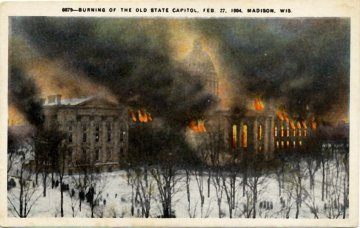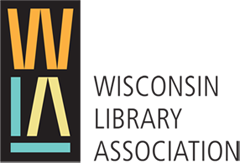
Two of Wisconsin’s most significant libraries were dramatically impacted by the fire that began in the late evening of February 26, 1904 and destroyed most of the State Capitol in Madison. Stanley H. Cravens article “Capitals and Capitols in Early Wisconsin” in the Wisconsin Blue Book for 1983-1984 contains an excellent account of the 1904 fire. A pdf version of that article is located HERE. The first library impacted was the Wisconsin State Library (now the Wisconsin State Law Library). Through quick action the library’s collection was mostly saved. Cravens describes the rescue as follows:
“University students continued to arrive to aid in the rescue and fire-fighting efforts. Because of thick smoke filling the building, they were unable to use the stairways and several ladders were secured and raised to the windows in the north wing, which contained the State Law Library. Once inside, they began throwing volumes out the windows to snow banks below; others below began stacking the books haphazardly until State Supreme Court Justice R. D. Marshall arrived and organized the students into lines to pass the books hand-to-hand to nearby stores and later, to waiting wagons. According to Solon J. Buck (who later became archivist of the United States), then a senior attending the University of Wisconsin, this effort grew to five to six hundred people ‘and it began to get too crowded to work’.”
The second library impacted, the Wisconsin Free Library Commission, did not fare nearly as well. Henry E. Legler, Secretary of the Commission, described the impact in the Fifth Biennial Report of the Commission. Legler wrote:”The Commission sustained a severe loss by reason of this fire, not only as regards the records, but in the books and material then on hand, and manuscript copies of important publications contemplated…. The Document department [later the Wisconsin Legislative Reference Bureau] which had acquired an exceedingly valuable collection of pamphlets and books, was entirely destroyed. Much of the destroyed material cannot be replaced, inasmuch as, prior to the fire, most of the state departments had transferred to the Document department the accumulated files gathered for years past…. During the eight years of the Commission’s existence, large and useful collections had been made of plans, photographs, and half-tone engravings of library buildings throughout the country, bibliographies, books on library economy, bulletins, reports, blanks, collections of children’s books, sample bindings, library devices, and technical tools of every sort. All of these collections, many of which were thought to be the best extant, were consumed. Of the traveling libraries, 28 were destroyed.” Legler continues: “Libraries throughout the country responded most generously to the request for material. To the Carnegie library of Pittsburgh, the Commission is indebted for a set of printed cards for 1,000 children’s books. The New York state library sent complete files of its own publications and other library literature. The public libraries of Cleveland, Providence, Cincinnati, and many older cities supplied valuable publications. The library of the University of Wisconsin made large contributions of library literature.”
About the postcard shown above, Cravens writes:”One of the first Madisonians to awake to the sight was 15 year-old Joseph Livermore, who had the presence of mind to use his vest-pocket Kodak to take a most spectacular, if not the only, night photograph of the Capitol fire. Livermore later made copies of the photograph to sell for 10 cents apiece to earn enough money to purchase a bicycle; his father, however, felt the price too exorbitant and made Joseph reduce the price to 5 cents. One of Livermore’s customers was a postcard printer, who ran off and sold hundreds of the postcards, without sharing any of the profits with the boy.”

I’ve never known about this fire. Thank you for such a comprehensive and yet brief report.